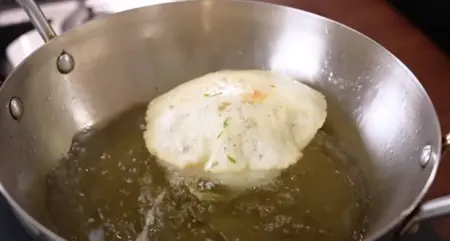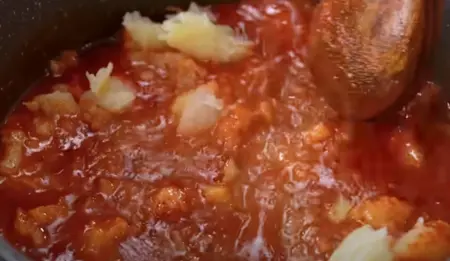
Sabudana ki Puri aur aloo ki sabzi

80 Mins

4 People

05 Mins
Introduction:
I remember the first time I tried Sabudana ki Puri with Aloo ki Sabzi. It was during a family gathering, and my grandmother insisted on making this dish for a special fasting day. I was skeptical at first, wondering how something as simple as sabudana could turn into a delicious puri, but the moment I took my first bite, I was hooked. The crispy, golden puri paired with the comforting, mildly spiced aloo sabzi had me going back for seconds!
Since that day, this dish has become a staple in my household, especially during Navratri. Not only is it filling and satisfying, but it’s also light on the stomach, making it perfect for fasting days. I’ve made it countless times since then, and I’ve learned a few tricks along the way to get that perfect crispy texture. Let me walk you through my version of Sabudana ki Puri aur Aloo ki Sabzi.
Ingredients:
For Sabudana Puri:
- 1 cup Sabudana (sago)
- 1 tsp Green chilli, chopped
- 1 tsp Ginger, chopped
- ½ tsp Sendha namak (rock salt)
- Pinch of Black pepper, crushed
- 1 medium-sized Potato, boiled & grated
- Sprinkle of Water (as needed)
- 1 tsp Oil (for dough)
- Oil (for frying)
For Aloo Ki Sabzi:
- 2 tbsp Oil
- 1 tsp Jeera (cumin seeds)
- 1 tbsp Ginger & green chilli paste
- 2 Fresh tomatoes, pureed
- 1 tsp Salt
- ½ tbsp Red chilli powder
- ½ tsp Turmeric powder
- Water (as required)
- 3 Potatoes, boiled & mashed
- 1 tbsp Kasuri methi (dried fenugreek leaves)
- 1 tsp Saunf powder (fennel)
- ½ tsp Sugar
Instructions:
Step 1: Lightly Roast the Sabudana
In a dry pan, lightly roast the sabudana over medium-low heat, stirring continuously to remove moisture. Be careful not to brown the sabudana. Once dry, remove from heat and allow it to cool completely. After cooling, grind the sabudana into a fine powder using a blender.
Step 2: Prepare the Sabudana Puri Dough
In a large mixing bowl, combine the ground sabudana powder, chopped green chilies, ginger, sendha namak, and crushed black pepper. Add the boiled and grated potato to the mixture and mix thoroughly. If needed, sprinkle a little water to form a soft, pliable dough. Make sure the dough is firm but not too wet.
Step 3: Roll Out the Puris
Place a plastic sheet on a flat surface and lightly apply oil to prevent sticking. Take a small portion of the dough, place it on the oiled sheet, and cover with another oiled sheet. Roll the dough into a flat, even circle with a rolling pin, aiming for a thickness of about 1/8 to 1/4 inch.
Step 4: Fry the Puris
Remove the top plastic sheet and carefully cut the rolled dough into rounds. Heat oil in a deep frying pan over medium heat. Once the oil is hot, gently slide the puris into the oil and fry in batches. Fry until the puris puff up and turn golden brown, flipping as needed. Drain on paper towels to remove excess oil.

Step 5: Prepare Aloo Ki Sabzi - Temper Spices
In a pan, heat 2 tablespoons of oil over medium heat. Add jeera (cumin seeds) and let them crackle. Add the ginger and green chili paste, sautéing until the raw aroma disappears.
Step 6: Cook the Tomato Base and Add Potatoes
Add the fresh tomato puree to the pan and cook until it thickens and the oil starts to separate. Stir in the salt, red chili powder, and turmeric powder. Cook for another minute before adding the mashed potatoes. Add water as needed to adjust the consistency and simmer for 5 minutes.

Sub-steps:
- Final Seasoning: Stir in kasuri methi, saunf powder, and sugar. Simmer for 2-3 more minutes to blend the flavors.
About the Recipe:
Sabudana ki Puri aur Aloo ki Sabzi is one of those classic combinations that works beautifully for fasting or regular meals. The sabudana puri is made with soaked sago pearls, mixed with mashed potatoes and a few subtle spices, which gives it a delicate yet irresistible flavor. The puris are crispy on the outside, soft inside, and have a unique texture that differentiates them from regular puris.
Paired with the comforting, mildly spiced aloo ki sabzi, this meal becomes a complete and wholesome dish. The sabzi is a simple, lightly spiced potato curry, which is perfect to balance the puris. This combination is not just restricted to fasting days; it makes for a great weekend brunch or even a light dinner.
What I love about this recipe is how versatile it is. You can play around with the spices to suit your preference, or even add a dash of lemon to brighten up the flavors. Whether you're fasting or just craving something different, this dish hits the spot.
Cooking Tips:
- Soak the Sabudana Properly: Always soak the sabudana for at least 4-5 hours, or even overnight. This ensures that the pearls are soft enough to bind properly with the mashed potatoes when making the puris.
- Add a Binding Agent: If your puris are falling apart while rolling, try adding a bit more mashed potatoes or even a spoonful of singhara (water chestnut) flour to help bind the dough.
- Fry at the Right Temperature: Make sure the oil is hot but not smoking. If the oil is too cold, the puris will absorb too much oil; too hot, and they’ll burn quickly without cooking through.
- Make the Sabzi Early: Prepare the aloo ki sabzi in advance and let it sit for a while. This helps the flavors meld together, giving it a richer taste when paired with the puris.
Pairing Guide:
Sabudana ki Puri aur Aloo ki Sabzi is perfect on its own, but you can enhance the meal by serving it with a few accompaniments. A cooling bowl of cucumber raita or a tangy imli (tamarind) chutney adds a refreshing contrast to the puris. You can also enjoy this meal with a light, chilled glass of buttermilk or a mildly spiced masala chai for a complete fasting experience.
For a fuller meal, you could also serve this dish alongside a bowl of fresh fruit salad, which pairs well with the subtle flavors of the puris and sabzi.
Frequently Asked Questions:
-
Can I make Sabudana Puri in advance?
Yes, you can make the dough for sabudana puri in advance and refrigerate it for up to a day. However, it’s best to fry the puris fresh for optimal crispiness. -
What if my sabudana puris keep breaking while rolling?
If your puris are breaking, it could be because your sabudana hasn’t soaked enough or the dough is too dry. Try adding more mashed potatoes to bind the mixture, or a little singhara flour to help hold it together. -
Is Sabudana Puri gluten-free?
Yes, sabudana puris are naturally gluten-free, as they are made from sago pearls and mashed potatoes. Just be sure to avoid adding any wheat flour. -
Can I bake the puris instead of frying them?
While traditionally fried, you can experiment with baking the puris. Preheat your oven to 200°C (392°F), brush the puris with oil, and bake them until they turn golden brown. They may not be as crispy, but it’s a healthier alternative. -
How can I store leftover Sabudana Puri?
Sabudana puris are best eaten fresh, but if you have leftovers, store them in an airtight container. Reheat them in an oven or air fryer to restore some of their crispiness. -
What are some alternative ingredients for Sabudana Puri?
You can try using boiled sweet potatoes instead of regular potatoes for a slightly sweeter taste. You can also experiment with adding crushed peanuts or grated coconut for extra flavor. -
Can I make this recipe without fasting?
Absolutely! While it’s popular during fasting days, sabudana puri and aloo ki sabzi make for a great meal any time of the year. -
What kind of potatoes are best for Aloo ki Sabzi?
Starchy potatoes like Russet or Yukon Gold work best for the sabzi, as they break down and absorb the flavors of the spices. -
Can I add other vegetables to the Aloo ki Sabzi?
Yes, you can add vegetables like carrots, peas, or even spinach to the sabzi to give it more depth and nutrition. -
Is Sabudana Puri suitable for weight loss?
While sabudana puris are delicious, they are fried and can be high in calories. If you're looking to reduce calorie intake, consider baking them instead or limiting portion sizes.
